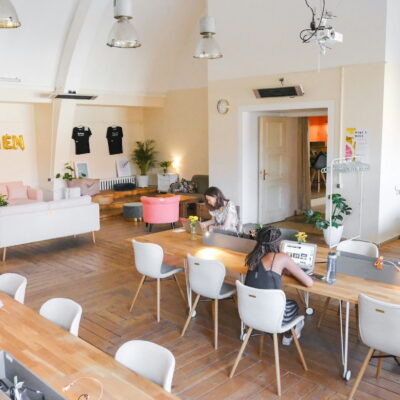The Receptionist for iPad is a visitor management software (VMS) with a clean interface that visitors understand in seconds. Small to mid-sized businesses choose it because it includes all the VMS basics without delving into workplace management.
But, does it hold up against other visitor management systems?
Well, let’s find out. Here’s what makes the software stand out, and when you should look into The Receptionist alternatives.
💡 TL;DR:
The Receptionist for iPad is a great VMS for small to mid-sized teams, with strong two-way messaging, flexible workflows, and transparent pricing. It only works on iPads (hence the name) and includes all features across all tiers, with the pricing being based on the number of employee contacts.
If you need Android or web kiosks, want SSO included without add-on fees, or want direct access control integrations without custom API work, consider The Receptionist alternatives like Archie.
The Receptionist vs alternatives
What is The Receptionist?
The Receptionist is a visitor management system designed to run on iPads in your lobby. Visitors check in on the tablet, get their photo taken, receive a printed badge, and trigger an instant alert to their host via text, email, Slack, or Microsoft Teams.
What you get with The Receptionist for iPad
- Custom check-in workflows: Button-based flows with custom fields for different visitor types (guests, interviews, deliveries, employees).
- Documents and e-signing: Collect signatures for NDAs, waivers, and safety rules with expiration dates for returning visitors.
- Badge printing and photos: Print custom badges with the visitor’s name, photo, host, company name, visit date, etc.
- Contactless check-in: Visitors can scan a QR code to check in from their own device.
- Pre-registration: Hosts can register guests ahead of time for faster check-in.
- Employee PINs: Staff can check in/out with personal PINs for basic presence tracking.
- Notifications: Send alerts to specific admins, let hiring teams claim interview candidates, broadcast evacuation messages.
- Real-time visitor log: See who’s on-site and export reports for audits.
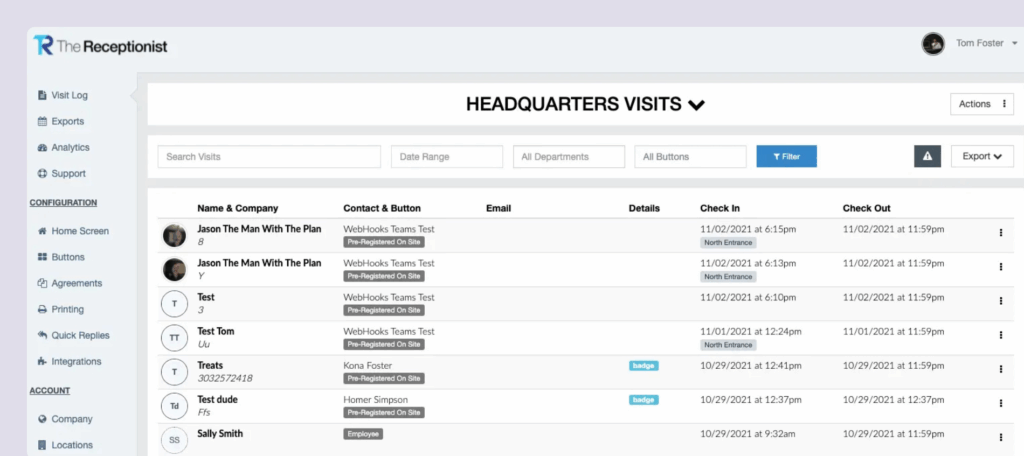
💡 Standout feature: The Receptionist’s two-way messaging. When a visitor checks in, their host can reply directly from their phone, with the response appearing on the kiosk screen. That way, the visitor knows what to do next, reducing lobby confusion and wait times.
How much does The Receptionist cost?
The Receptionist charges per location, with the cost increasing based on the employee count. All the features are included with every pricing plan. So, you essentially pay more if you have more employees.
The pricing for the platform looks as follows:
- Basic: $60/month or $630/year for 1–24 employees
- Premium: $114/month or $1,197/year for 25–49 employees
- Pro: $210/month or $2,205/year for 50–99 employees
- Executive: $360/month or $3,780/year for 100+ employees
The Receptionist also offers a 14-day free trial and a money-back guarantee. Teams usually go live within about a week. So, you’ve got a week for the setup, and see if the platform’s worth it for you.
💡 Add-ons: SSO is available as a paid add-on (not included in the base price).
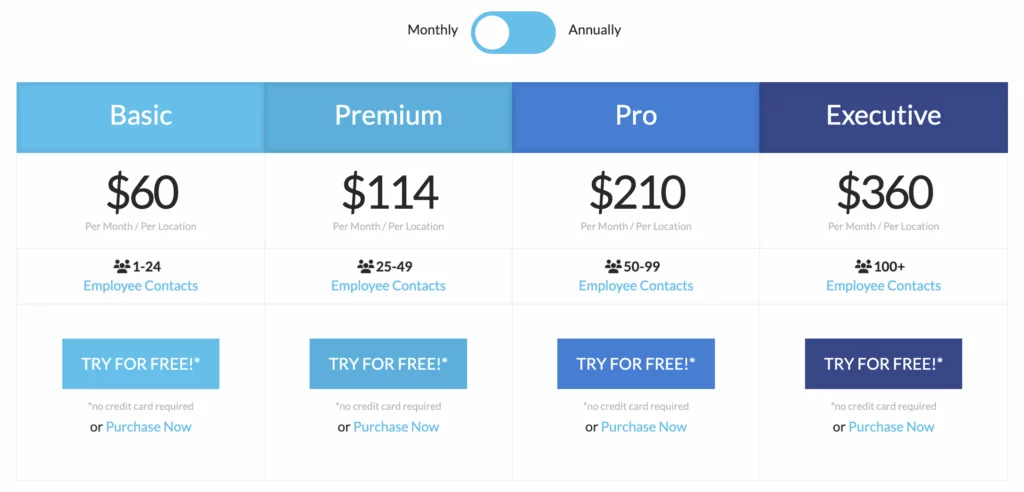
What’s great about The Receptionist
🟢 Smooth iPad experience. The whole check-in experience is smooth and easy to understand on both the visitors’ and admins’ sides. It can also be fast-tracked with pre-registration and scanning the QR code on the screen.
🟢 Two-way messaging works well. Hosts appreciate being able to reply to check-in alerts from their phone. It reduces back-and-forth, making the whole process faster and less confusing.
🟢 Easy to set up with very responsive customer support. Reviewers consistently praise how straightforward the setup is. Support also gets positive mentions across the board for being helpful during onboarding and responsive when issues come up (so much so that reviewers name the support team members who have helped them).
🟢 Solid compliance features. E-signature collection with expiration dates, photo capture, badge printing, and exportable visitor logs cover most audit requirements at an affordable price.
🟢 All features included. Unlike competitors with feature-gated tiers, every plan includes workflows, e-signing, badges, and two-way messaging.

Why you might want to consider The Receptionist alternatives
🔴 iPad only. Reviewers note that, in addition to not being able to use their Android or Windows devices, iPads also tend to be more expensive.
🔴 SSO is a paid add-on. For mid-sized and large companies, paying separately for single sign-on feels unnecessary when it’s considered an industry standard feature.
🔴 Access control requires custom work. No native integrations with popular door access systems. You’ll need webhooks or their OpenAPI (aka, extra IT resources and costs).
🔴 Customization limits. Several reviewers mentioned that the platform offers less customization than they expected. One user on Software Advice explained that certain button types limit what the back office can do, such as claiming visitors, which sometimes forces multiple people to handle the same check-in.

💡 Bottom line: The Receptionist is a good choice for small to mid-sized companies that want a dedicated, iPad-based visitor kiosk with strong two-way messaging. If your team uses non-Apple devices, wants SSO included at no extra cost, needs more customization or direct access control integrations without custom API work, The Receptionist might not be enough.
Luckily, we know a few alternatives to the Receptionist for iPad.
What's the best alternative to The Receptionist?
For most mid to large teams and offices, Archie is the best alternative to The Receptionist for iPad.
It delivers on what The Receptionist does well, like intuitive check-ins, custom workflows, badges, e-signing, and notifications. And, it addresses some of its key limitations like cross-platform support (iPad and Android), SSO and SCIM included at the Pro tier, and native access control integrations.

The Receptionist alternative #1: Archie
Archie is a workplace management platform that combines visitor management with desk booking, room reservations, and workplace analytics. So, instead of you having to use separate tools, you get one unified system for employees, admins, and visitors.
To compare it with The Receptionist fairly, though, let’s just focus on the VMS side of things.
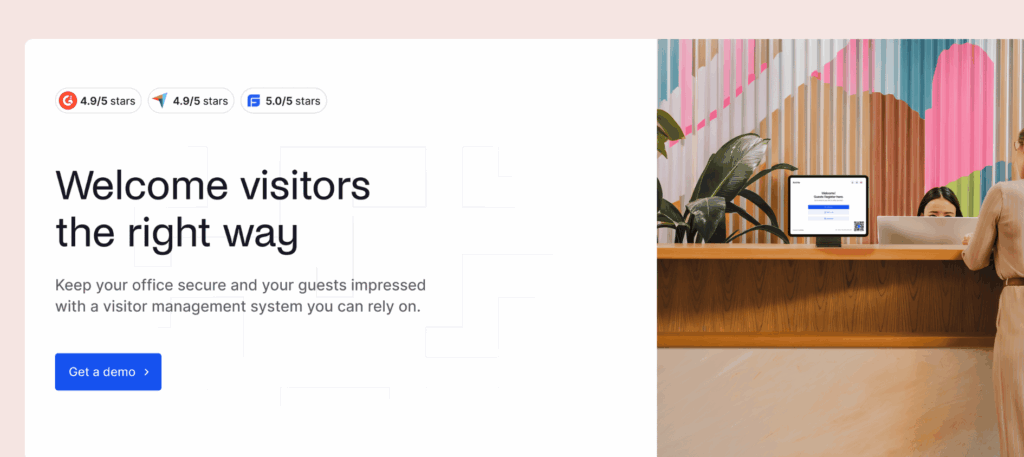
The visitor management module covers all the essential features. You get custom check-in flows, contactless check-in, e-signatures, badge printing, host notifications, and real-time visitor logs.
Then there are the extras, like deeper integrations for access control, SSO, and SCIM at the Pro plan, and an overall cleaner interface, which make it a great fit for mid- to large-sized companies.
What you get with Archie Visitors
- Cross-platform kiosks: Works on iPad and Android tablets, without needing any special hardware.
- Custom check-in workflows: Highly automated flows that can be configured for different visitor types with custom fields.
- E-signatures and document storage: Collect signatures for NDAs and compliance docs with secure storage.
- Badge printing and photos: Badge templates with visitor photos, as well as expiring badges for returning visitors.
- Host notifications: Email, SMS, Slack, and Teams alerts.
- Pre-registration and QR check-in: Fast check-in for pre-registered guests via QR code.
- Direct access control integrations: Native connections to Kisi, Salto, Tapkey, and Brivo, reducing your IT costs.
- SSO and SCIM: Single sign-on and directory sync are included at the Pro tier, adding an extra layer of security.
- Workplace analytics: Utilization reporting across visitors, desks, and rooms.
- Emergency notifications: Broadcast alerts to everyone on-site in case of an emergency.
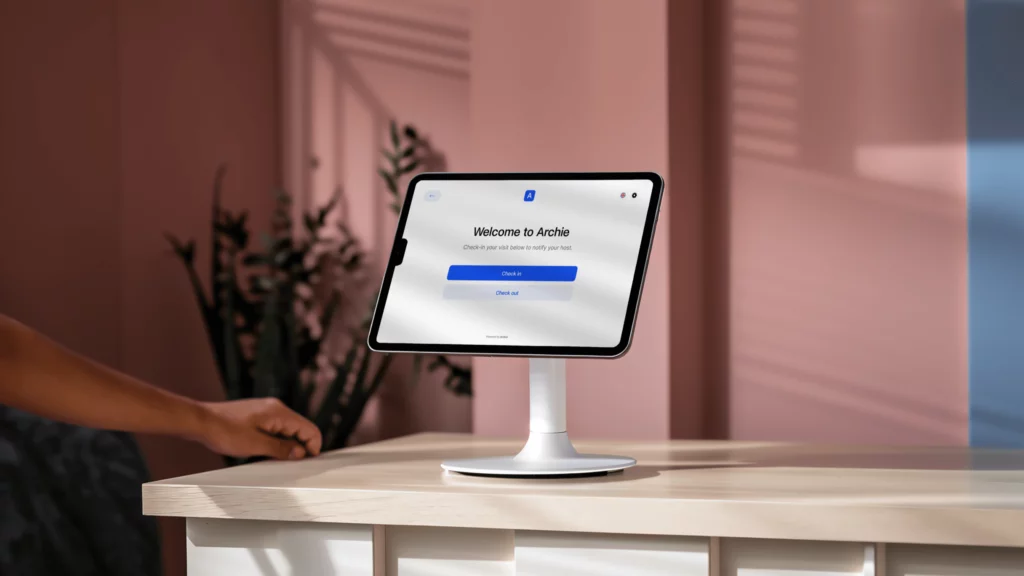
How much does Archie Visitors cost?
Archie’s visitor management pricing is per office, not per user or per visitor. All plans include unlimited check-ins, with the pricing plans being as follows:
- Starter: $109/month per office
- Pro: $185/month per office (includes SSO and SCIM)
- Enterprise: Custom pricing
Desk booking and room scheduling are available as additional modules. There’s also a free trial, and you can book a demo to get your team on Archie.
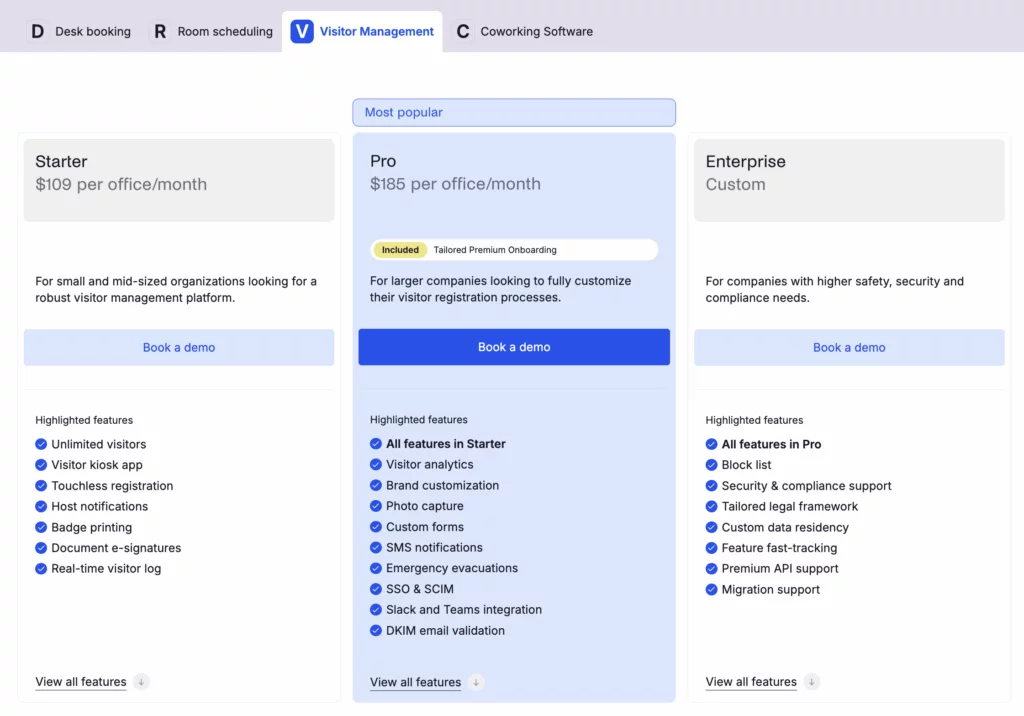
Who’s Archie Visitors best for?
Archie is best for mid-sized and large offices that want visitor management inside a wider workplace platform.
With iPad and Android tablets as options, you’ll be able to have the flexibility you need for each of your offices. Also, Archie’s got you if you expect SSO and SCIM without add-on fees and want direct access control integrations without custom API work (even though open API is also available if needed).
The platform suits organizations with multiple locations that want centralized admin and better value at scale. Also, if your team prefers a single unified system rather than managing separate tools for visitors, desks, and rooms, Archie is one of the best options available.

Archie Visitors limitations
Archie doesn’t offer two-way messaging, where the host’s replies appear directly on the kiosk screen, which is The Receptionist’s standout feature. If that specific workflow is critical to your lobby operations, The Receptionist may be a better fit.
The platform may also be more than needed for very small offices that only want a simple visitor kiosk.
How Archie compares to The Receptionist
Both platforms handle the core visitor management workflow well. Whether you choose Archie or The Receptionist, you’ll get custom check-in flows, e-signatures, badge printing, photo capture, host notifications, and real-time visitor logs. Both offer pre-registration and contactless check-in options, and both have good reputations for reliability and support.
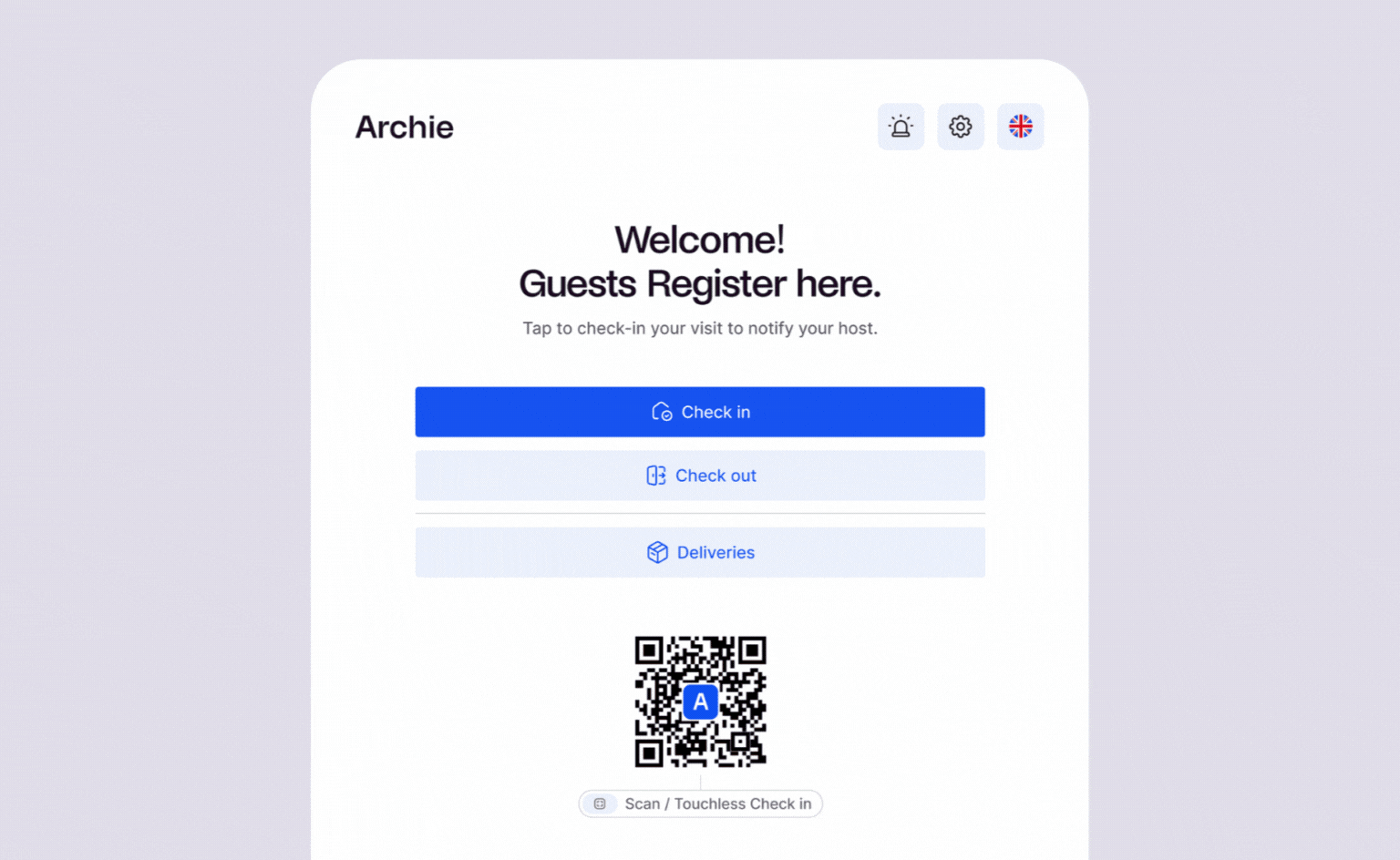
The Receptionist shines in its two-way messaging and is the choice for small offices that just want everything unlocked from day one. Archie is a better overall option if you don’t want to be locked into Apple hardware, need SSO and SCIM, or want direct integrations with access control systems.
The Receptionist alternative #2: SwipedOn
SwipedOn is a VMS that does two essential things really well: fast rollout and ease of use. It supports both iPad and Android tablets, making it more flexible than iPad-only solutions. And it offers clear, tiered pricing that’s predictable and, according to many reviews, budget-friendly.
The platform covers visitor check-ins, employee in/out tracking, deliveries, and basic compliance features. It’s popular with small and mid-sized businesses, as well as schools and nonprofits that want the essentials done well without complexity.
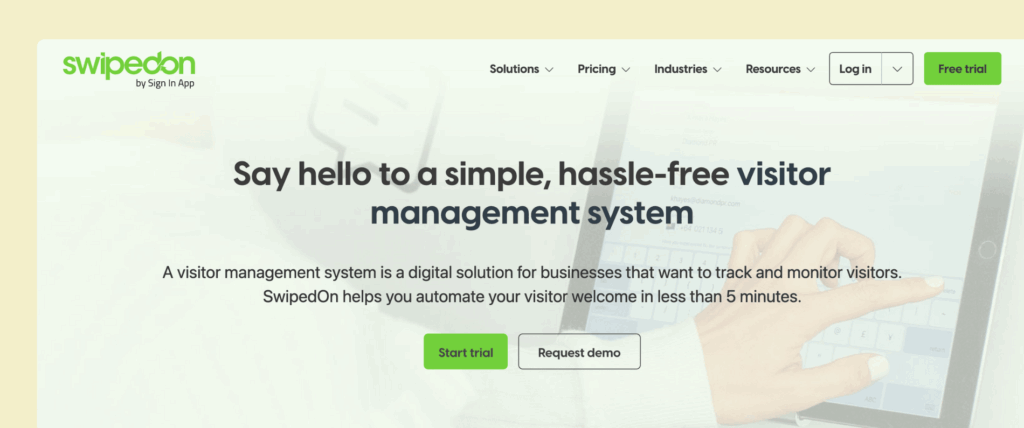
What you get with SwipedOn
- iPad and Android support: Runs on both OS for hardware flexibility.
- Visitor check-in: Custom fields, photo capture, and badge printing for a streamlined visitor experience.
- Employee in/out board: Track who’s on-site with a simple dashboard.
- Delivery management: Log packages and notify recipients to simplify the delivery process.
- Document signing: Collect e-signatures for NDAs and policies for compliance purposes.
- Host notifications: Email and SMS alerts (SMS is an add-on).
- Pre-registration: Register guests ahead of time for faster check-in.
- Contactless check-in: QR code check-in from the visitor’s own device, to make the check-in process faster and simpler.
- Reporting and exports: Visitor logs with search and export.

How much does SwipedOn cost?
SwipedOn uses per-location pricing with tiered features. Every plan includes unlimited employees and visitors and is annually billed.
- Starter: $49/month per location (basic features)
- Business: $99/month per location (most features)
- Enterprise: $169/month per location (advanced features and support)
💡 Add-ons: SMS notifications, visitor preboarding, and delivery management are also available as paid add-ons.
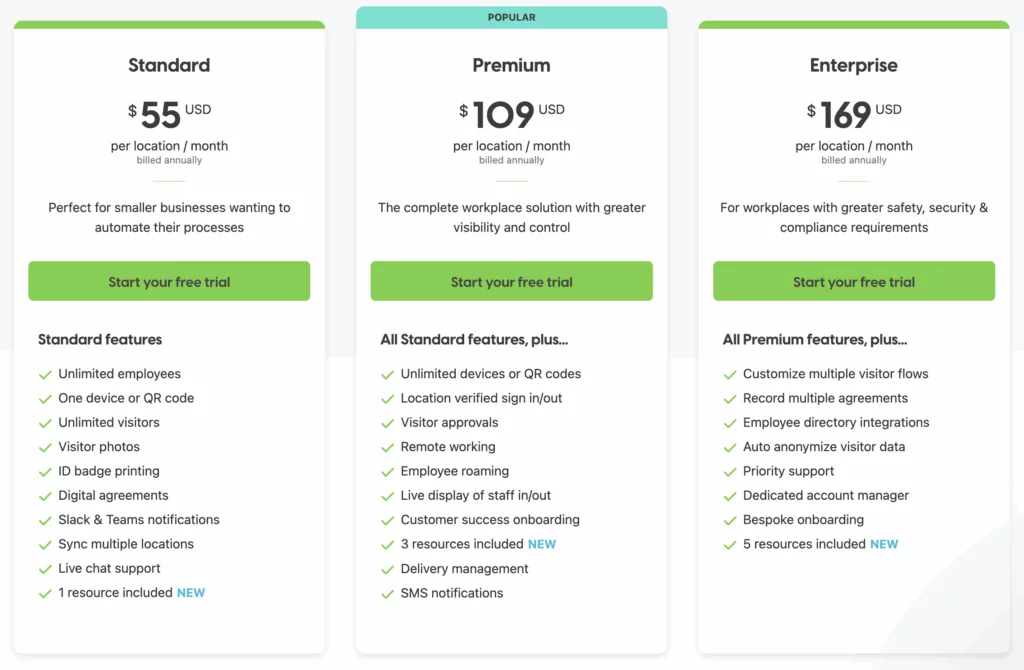
Who’s SwipedOn best for?
SwipedOn is best for small and mid-sized teams that want a straightforward VMS with iPad and Android support at a budget-friendly price.
It’s a good fit for schools, nonprofits, and organizations that need the essentials, like check-ins, badges, notifications, and basic compliance, without the complexity of enterprise tools.
The employee in/out board is a handy feature for tracking who’s on-site, and the clear tiered pricing makes costs predictable.
SwipedOn limitations
SwipedOn lacks some enterprise features that larger organizations need. SSO and advanced directory integrations are available only in the highest tier. In terms of integrations, the native suite is very limited.
SMS notifications alongside other add-ons cost extra, which can quickly add up for larger offices and teams. Analytics and reporting are fairly basic compared to more enterprise SwipedOn alternatives.

How it compares to The Receptionist
Both The Receptionist and SwipedOn are designed for ease of use and fast rollout. They cover the basics, like check-ins, badges, photo capture, notifications, e-signatures, and visitor logs, and have good reputations for being user-friendly and reliable.
On the one hand, The Receptionist’s two-way messaging makes the digital check-in process more impressive. Plus, all features are included at every tier, while SwipedOn gates some features to higher plans.
On the other hand, SwipedOn supports both iPad and Android tablets, addressing The Receptionist’s biggest hardware limitation. Entry-level pricing starts lower ($49/month vs $60/month), and comes with unlimited employees, which is a great value for small to mid-sized teams.
The Receptionist alternative #3: Lobbytrack
Lobbytrack is a visitor management system built for organizations with serious security and compliance requirements. It supports iOS, Android, and Windows kiosks with separate apps for the reception, employees, and security guards.
Lobbytrack has plenty of features besides check-in basics. ID scanning, watchlist screening, queue management, and evacuation tools make it a strong pick for manufacturing facilities, government offices, and any organization where security workflows are critical.

What you get with Lobbytrack
- Multi-platform support: iOS, Android, and Windows kiosks, offering a lot of hardware flexibility.
- Role-based apps: Separate apps for reception, employees, and security guards.
- ID scanning: Scan driver’s licenses and passports for identity verification, adding extra security when you have drivers and contractors coming in regularly.
- Watchlist screening: Check visitors against internal or external watchlists for even more security.
- Badge printing: Custom badges with photos and visitor details.
- Document signing: E-signatures for NDAs and compliance documents.
- Host notifications: Email, SMS, and app-based alerts.
- Queue management: Manage visitor flow in busy lobbies to keep everything organized.
- Evacuation tools: Emergency mustering and headcount features.
- Pre-registration: Register guests ahead of time to keep their check-in process.
- Reporting and analytics: Detailed visitor logs and compliance reports.
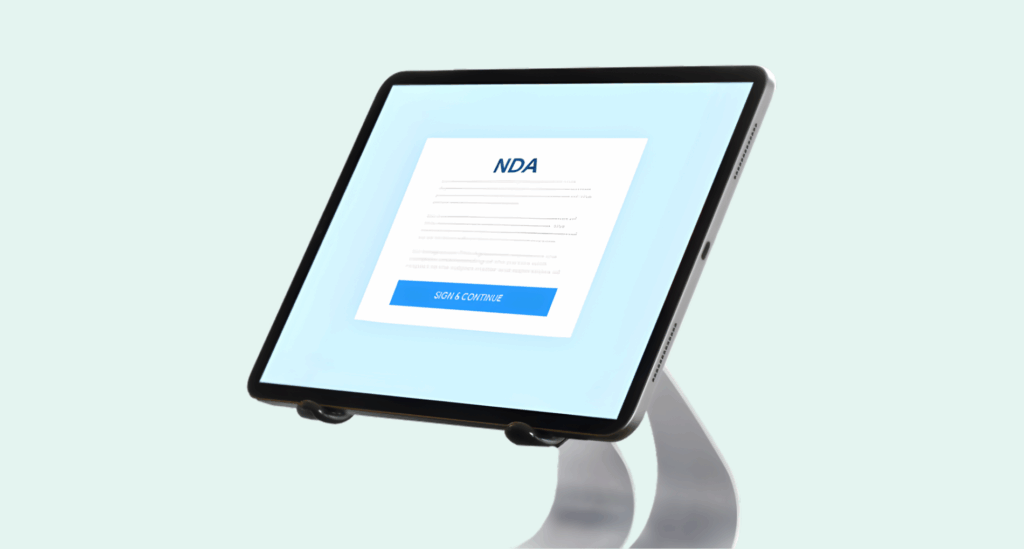
How much does Lobbytrack cost?
Lobbytrack offers tiered pricing based on features and scale. All plans have unlimited hosts and come with the VMS essentials:
- Starter: Free (limited features, 1 location)
- Basic: $50/month per location
- Professional: $100/month per location
- Enterprise: Custom pricing
Advanced features like ID scanning, watchlists, and evacuation tools are available on higher tiers.
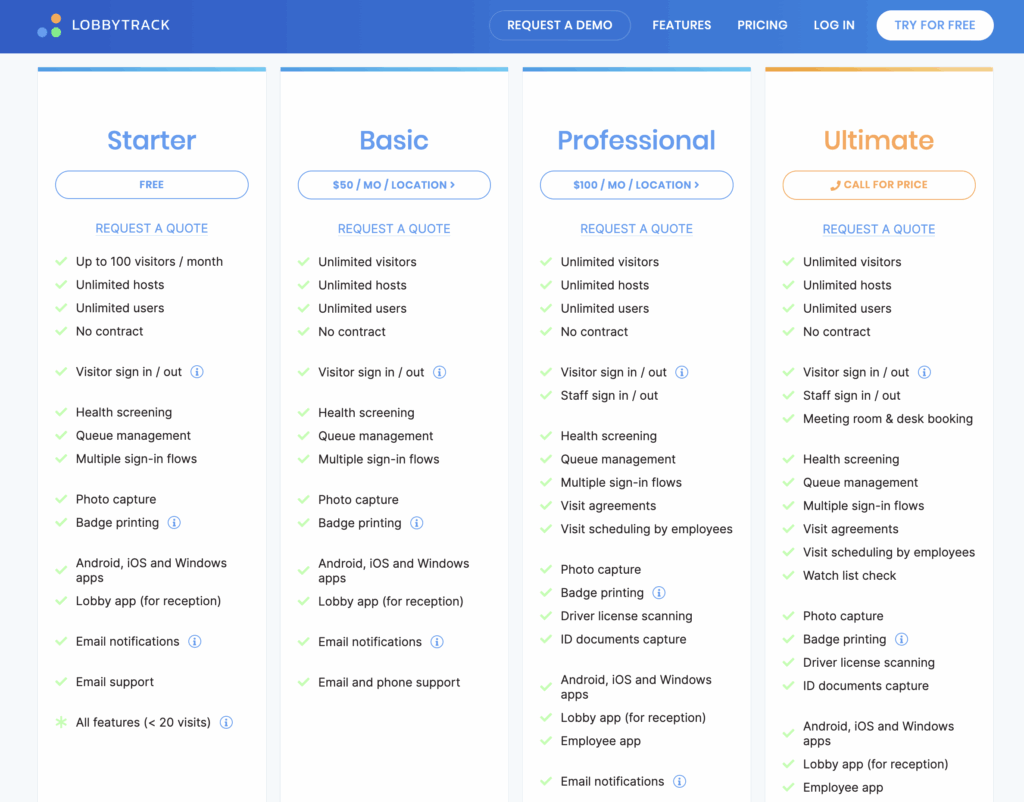
Who’s Lobbytrack best for?
Lobbytrack is the best option if you need more than basic visitor check-ins. Its features suit manufacturing plants, government facilities, healthcare organizations, or any workplace where ID verification, watchlist screening, and emergency tools are essential.
The multi-platform support (including Windows) and role-based apps make it flexible, allowing for complex reception setups with multiple entry points and security personnel. The evacuation and queue management features are neat extras that you won’t always find in VMS.
Lobbytrack limitations
One of the main things reviewers have to say about Lobbytrack is that its interface isn’t as polished or intuitive as some competitors. The setup can be more complex as well, especially for advanced features. The free tier is very limited and mostly useful as a demo.
Plus, some advanced features require higher-tier plans, so costs can escalate depending on what you need. Customer support gets mixed reviews compared to Lobbytrack competitors.

How it compares to The Receptionist
The Receptionist and Lobbytrack handle core visitor management features: check-ins, badges, e-signatures, notifications, and visitor logs are all there. And, both are focused on visitor management rather than broader workplace functions.
Lobbytrack supports Windows and Android kiosks in addition to iOS, compared to just iPads. The security features make it stand out for security-heavy teams. Role-based apps for reception, employees, and guards allow for more complex workflows.
The Receptionist offers a more polished visitor and admin experience. Features like two-way messaging make it feel more modern. Plus, all the features are included at every tier. For orgs that don’t need Lobbytrack’s security-heavy features, The Receptionist can deliver a better day-to-day experience.
The Receptionist alternative #4: Envoy
Envoy needs no introduction, as it’s one of the most well-known visitor management systems in the industry. It’s known for its great, polished lobby experience and large number of native integrations. The higher tiers offer advanced security features like ID scanning, restricted-party screening, and Wi-Fi provisioning.
The platform started as a visitor management tool and has expanded to include desk booking, room scheduling, and workplace analytics. We’ll only cover the VMS to keep the comparison fair.
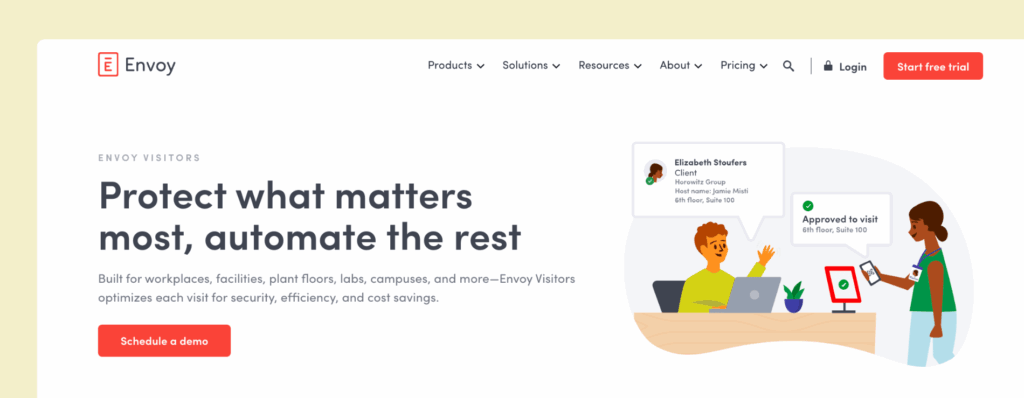
What you get with Envoy Visitors
- Polished iPad experience: Clean, professional check-in interface.
- Custom sign-in flows: Different workflows for visitors, employees, and contractors.
- Badge printing and photos: Custom badges with visitor details.
- Host notifications: Email, SMS, Slack, Teams alerts.
- Pre-registration: Invite guests ahead of time for faster check-ins.
- Document signing: E-signatures for NDAs and compliance docs.
- Large integration marketplace: 100+ integrations with HR, IT, security, and access control systems, so you don’t have to use extra IT resources.
- Analytics and reporting: Detailed visitor and workplace insights.
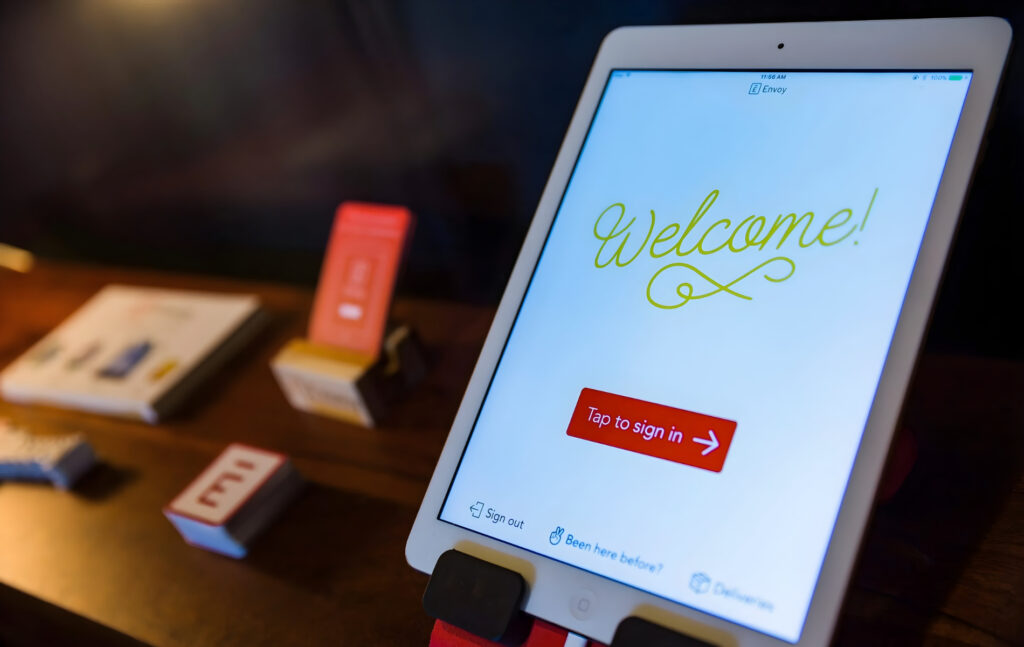
How much does Envoy Vistors cost?
Envoy uses per-location pricing for visitors, with every plan including unlimited visitors and host notifications:
- Basic: Free (limited features)
- Premium: $329/month per location
- Enterprise: Custom pricing
Most of the advanced features are locked behind the Premium and Enterprise plans, and all plans are billed annually.
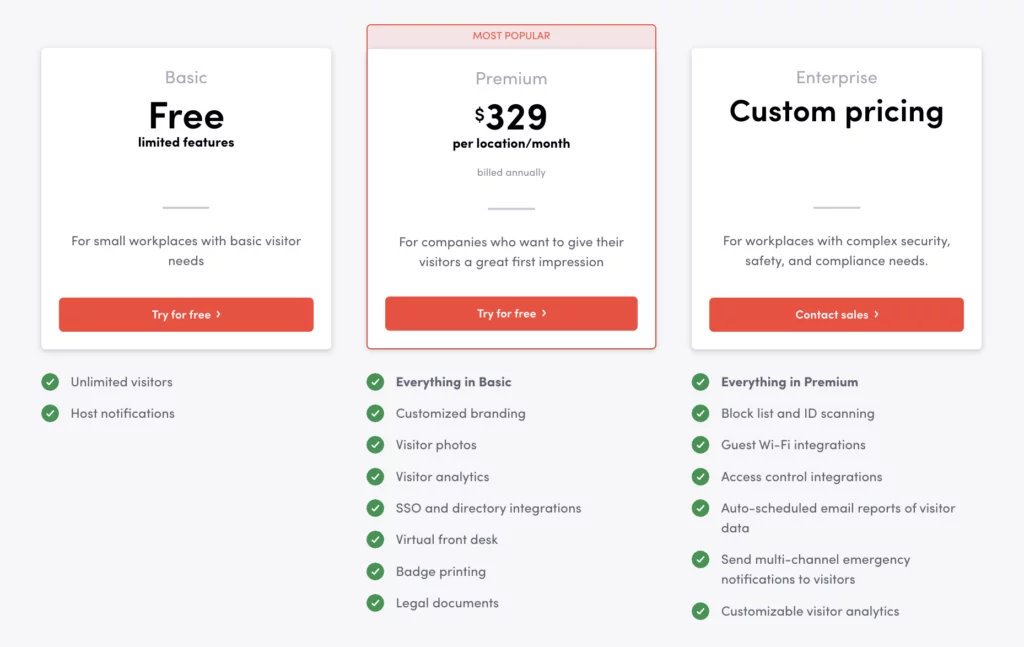
Who’s Envoy Visitors best for?
Envoy is best for mid-sized and enterprise organizations that want a polished VMS with a great UI, deep integrations, and advanced security options. It’s the best choice for you if your company wants a modern lobby experience, needs to connect visitor management natively with other systems, and is willing to pay premium pricing for advanced features.
The integration ecosystem and check-in process are the biggest selling points. Envoy connects with over 100 tools, making it a good fit for enterprises with complex tech stacks, and streamlining the check-in process when you have tons of visitors coming in each month.
Envoy Visitors limitations
Envoy’s pricing can add up quickly, which is one of the main reasons people look for Envoy alternatives. Many popular features (ID scanning, restricted-party checks, Wi-Fi provisioning, and access control integrations) are only on the Premium tier or require custom pricing. Starting at $329/month per location for an advanced feature set, it’s one of the most expensive visitor management systems on the market.

Plus, Envoy Visitors is iPad-only, which limits hardware flexibility. The free tier is very limited and is best treated as a demo before you commit to a full plan.
How it compares to The Receptionist
The Receptionist and Envoy Visitors offer a polished iPad experience. Both have all the core visitor management features, like custom workflows, badges, e-signatures, notifications, and visitor logs.
Envoy offers significantly more advanced security features on premium tiers. Plus, the integration marketplace is much larger (100+ apps vs The Receptionist’s more limited set).
On the other hand, The Receptionist’s pricing is more transparent and affordable, with all features included at every tier, while Envoy gates major features to Premium. The Receptionist is simpler to set up and use without enterprise complexity.
Other alternatives to The Receptionist
If none of the options above fit your needs, here are other visitor management systems worth considering:
- Greetly: Customizable and affordable, supports iPad and Android, good for smaller businesses.
- Eptura Visitor: Best for global organizations with strict compliance needs and centralized, multi-site administration.
- VisitorOS (formerly iLobby): Best for security-heavy sites that want a ready-to-deploy hardware + software bundle.
- Visitly: Budget-friendly option with basic features and simple pricing.
- Vizitor: Best for cost-conscious teams that want touchless QR check-in and basic integrations.
- Honeywell Sine: Best for multi-site operations that want strong mobile check-in, contractor flows, and geofencing.
Which The Receptionist alternative should you choose?
There are quite a few The Receptionist alternatives to consider. And, even though we covered some of these, there are still many visitor management solutions that might fit your business better. To choose the best one for your needs, think about:
✅ Hardware flexibility. Decide if iPad-only works for you, or if you need Android or Windows kiosks. There are still some Receptionist alternatives that lock you into Apple hardware (like The Receptionist or Envoy), while others, like Archie, give you more OS options.
✅ Security and compliance. Determine how much security you really need. Is a basic check-in and a badge enough, or do you need ID scanning, watchlists, approvals, data retention rules, and audit-ready logs?
✅ Workflow depth. Check how easily you can customize the sign-in for different visitor types, add custom questions, collect e-signatures, and set approval rules.
✅ Integrations. Look for native access control integration, SSO/SCIM, communication apps like Slack or Teams, calendars, Wi-Fi, and APIs or webhooks to build custom flows.
✅ Total cost. Price the entire setup: tablets, badge printers, add-ons, and features that may sit in higher tiers or be treated as add-ons, such as SSO or access control. The Receptionist charges extra for SSO, so make sure you factor that in when comparing.
✅ Admin experience. Try the dashboard. See how many clicks common tasks take and whether roles for reception, security, and site admins are straightforward.
✅ Analytics and reporting. You should get a live “who’s on site” view, evacuation lists, trends, exports, and scheduled reports without jumping through hoops.
✅ Reliability and support. Check uptime, support hours, and response times. Recent reviews are great for spotting real-world support quality.
✅ Scalability. Make sure licensing, performance, and admin controls still feel smooth as visitor volume grows and new locations come online.
✅ Features beyond visitor management. Consider whether you also need desk booking, room scheduling, or workplace analytics. Some platforms bundle these together, simplifying your tech stack and reducing costs.
Shortlist two or three options and schedule demos. Pre-register a guest, print a badge, trigger an approval, and export a report. Pick the one that’s fastest for visitors and easiest for your team.
Why Archie is usually the best all-around pick
- Cross-platform flexibility. Archie runs on iPad and Android, so you’re not locked into Apple hardware.
- SSO and SCIM are included. Unlike The Receptionist, Archie includes single sign-on and directory sync at the Pro tier without add-on fees. That’s a major win for IT and security teams who expect SSO as a baseline.
- Strong security without extra bolt-ons. You get custom flows, e-signatures, and built-in document management for NDAs and policies, as well as native access control integrations with Kisi, Salto, Tapkey, and Brivo. You won’t have to get IT to do any custom API work required.
- One platform, less friction. Archie covers visitors, desks, rooms, and occupancy reports in one product, so you avoid combining tools together.
- Predictable pricing and fast rollout. Plans are modular and per location with unlimited visitors, so budgeting is straightforward.
- Admin-friendly at scale. A clean UI and automated visitor workflows reduce front-desk effort. Centralized admin makes managing multiple locations straightforward.
Quick head-to-heads
- Archie vs The Receptionist: Both handle core visitor management well, but Archie addresses The Receptionist’s main limitations: Cross-platform support, SSO included, and native access control integrations. The Receptionist wins on two-way kiosk messaging.
- Archie vs SwipedOn: SwipedOn is simple and great value for basics. Archie adds deeper customization, analytics, access control, SSO/SCIM, and space management for mid-sized and large organizations, while still being within a similar price range to SwipedOn.
- Archie vs Lobbytrack: Lobbytrack is strong for security-heavy workflows with ID scanning, watchlists, and guard apps. Archie unifies visitors, desks, and rooms into a single suite and includes native document management, without splitting tasks across several apps.
- Archie vs Envoy: Envoy is polished, with a huge integration marketplace, but it gets pricey fast, is iPad-only, and gates major features to premium tiers. Archie delivers strong security and automations on iPad and Android with a more balanced total cost.
Sources
- The Receptionist feature & pricing pages
- Demo videos
- G2 & Capterra profiles
- Archie’s product research

Alexios Georgakopoulos
Archie’s Content Writer, coffee fiend, and resident Gen Zer who hates working in offices but loves writing about them. When he is not deep in hybrid work and coworking topics, he is obsessing over a new hobby that will probably last about a day.
























